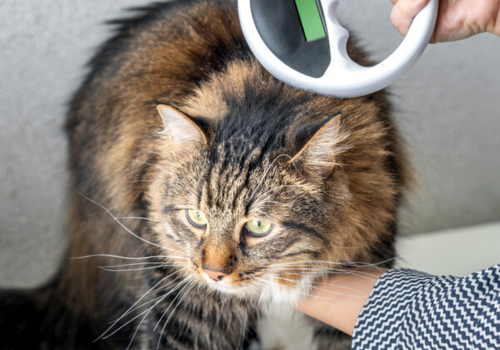If your cat has ever gone exploring or gotten lost and you had no idea how you could get them back to you, you know how important it is to have some form of identification on your furry friend. Tags and collars aren't always sufficient in ensuring your cat will find their way back to you, but microchipping certainly is. We all want our pets safe, and microchipping your cat is a great way to ensure they will make it home when they have wandered too far or found themselves in tricky situations.
If you are in the Miller Place area, we would be happy to microchip your cat or even answer some questions you may have, so feel free to reach out to us at (631) 744-2050 to schedule an appointment or talk through some possible concerns
What is Cat Microchipping?
Cat microchipping is a simple and safe procedure that involves implanting a small RFID (radio frequency identification) tag with a unique identification number under your cat’s skin.The chip contains a unique number that the appropriate scanner can register. This unique number is directly linked to your contact information, which is stored in a secure database so that whoever found your feline friend can reach out to you and ensure your cate is returned to their home safely. This tag does not actively transmit any information but rather passively stores the identification number, which a special microchip scanner can access. The primary purpose of cat microchipping is to serve as a permanent form of identification in the case that your pet got lost.

Why Do Veterinarians Recommend Cat Microchipping?
Veterinarians always recommend you microchip your cat because a microchip serves as a permanent form of identification that is used to locate a pet owner should their furry friend get lost. Microchips are also useful in cases where a cat’s collar or tags have been removed or lost, as they provide an additional layer of security.
In some countries, microchipping cats is required by law, so pet owners must comply with the law in order to avoid possible fines. Additionally, the process of microchipping itself is quick, simple, and causes very little discomfort to cats. It takes only a few seconds and does not require anethesia. Even indoor cats should be microchipped as there is always a chance that they could accidentally slip out at some point. Finally, microchipping helps animal welfare organizations avoid putting down unidentified pets by providing them with a way to identify cats and return them to their owners easily.
Is Microchipping Dangerous or Painful for My Cat?
Microchipping is very safe and is considered to cause minimal discomfort or pain. The process involves injecting a tiny microchip, about the size of a grain of rice, under the cat’s skin between the shoulder blades with a syringe. This causes only a pinch similar to a blood draw, so most cats do not show signs of discomfort during the procedure. Some pet owners choose to have their cat microchipped when they are spayed or neutered to eliminate potential discomfort, but it is not necessary.
The risk of side effects from microchipping is also very low. Migration of the chip and rare cases of tumor development at the injection site have been reported, although there is no proven correlation between these two things. Overall, the potential risks are minimal compared to the benefits provided by this technology. In fact, many veterinarians recommend this to be a standard part of kitten plans.
How Is a Cat Microchip Used to Identify My Cat?
When a cat is microchipped, its unique identification number is stored in a database along with the owner’s contact information. This information can be accessed by scanning the cat’s microchip with a special reader and then contacting the registry to access the owner’s contact details. This helps ensure that your cat can be properly identified and reunited with you if it ever gets lost or stolen.
It is important to keep your contact details up to date in the registry, as this is the only way of ensuring that you will be contacted if your pet is found. It is also recommended that you have your cat’s microchip registered with more than one database to increase its chances of being identified if it gets lost.
Why Does My Cat Need a Microchip if They Already Have a Collar with a Tag?
While collars and tags are essential as the first line of defense in identifying a lost pet, microchipping offers additional security by providing a permanent and reliable identification method. Collar tags can be removed or lost, leaving the cat without any form of identification. They also have limited space for information, which might not be enough to convey important details about the cat's owner, medical conditions, or other essential data. Additionally, collar tags can become worn, dirty, or damaged, making the information on them difficult to read.
Furthermore, not all Good Samaritans know about microchips and might not think to check for one if they find a lost pet. The combination of both microchips and collar tags increases the chances of reuniting lost pets with their owners and ensures that all necessary information is available in case the pet is found.
Will My Cat’s Microchip Be Able to Tell My Cat’s Location?
No, cat microchips do not contain GPS technology and cannot actively track a pet's location. Microchips are identification tools that rely on the pet being found and scanned for its unique identification number in order to access the owner’s contact information stored in a registry.
GPS tracking devices and Bluetooth trackers are available for pets as alternatives to microchips, but these devices have their own limitations, including battery life and range limits. While they offer more active tracking capabilities compared to microchips, they cannot eliminate all potential risks to a pet such as theft, injury, or disease.
Who Can Scan My Cat’s Microchip Information?
There are several individuals and organizations that are equipped to scan a cat's microchip: 1. Veterinarians: Most veterinary clinics have microchip scanners and can help pet owners scan their cat's microchip during routine examinations or when necessary. 2. Animal Shelters: Shelters typically have a microchip scanner on hand to check for microchips in stray or lost animals brought to their premises. This aids in contacting the pet's owner and facilitating a reunion. 3. Animal Control Officers: They carry scanners and will scan lost pets they encounter to determine whether they have microchips and ultimately locate their owners. 4. Some pet scanning services/applications: In some cases, pet owners can purchase handheld microchip scanners from companies like PetScanner, which provide a cost-effective way to scan their pet's microchip at home.

When Will a Cat Microchip Be Scanned?
A cat microchip is typically scanned under the following circumstances: 1. If a pet is found and brought to a veterinarian, animal shelter, or rescue organization, it is standard procedure for the staff to scan the pet using a microchip scanner. This is to check if the pet has a registered microchip, which can help in locating and contacting the owner. 2. In some cases, veterinary practices might scan a cat during a routine appointment or new patient registration. 3. If a cat is involved in an accident or natural disaster, microchips can help identify the pet during rescue or recovery operations.
What If I Forget or Lose My Cat’s Microchip Information?
It is essential that pet owners keep their contact information up-to-date in the registry linked to their cat's microchip. This ensures that they will be contacted if their pet is found. If you forget or lose your cat’s microchip information, there are a few steps you can take to recover it: 1. Contact the microchip company and provide them with your cat’s serial number, if you have it available. 2. Update information on microchip registries, such as Found Animals or AKC Reunite. 3. Call local animal control and animal shelters and provide your cat's information, including the fact that it is microchipped. 4. Post flyers with clear photos of your cat in the area where it went missing and mention that it is microchipped.
What Is the Difference between a GPS and an RFID Device?
GPS (Global Positioning System) and RFID (Radio-Frequency Identification) devices are two very different technologies used for different purposes when it comes to pet tracking and identification. GPS devices enable pet owners to track their pets' real-time location using satellites, while RFID microchips act as a passive identification system that does not provide any tracking features. Instead, the chip contains a unique identification number that can be used to access the owner's contact information from a registry.
GPS devices actively transmit location data and often come with a smartphone application that pet owners can use to monitor their pets' location, setting up virtual fences or receiving alerts if their pet moves out of a predetermined safe zone. On the other hand, RFID microchips only become useful after a lost pet has been found; a scanner at a veterinarian's office or shelter reads the microchip's unique ID number and retrieves the owner's contact information from the database.
Conclusion
Microchipping your cat is extremely safe and straightforward and could go a long way in getting your pet home if they get lost. Unlike collars and tags, a microchip won't get separated from your cat, so whatever situation they got into, you will be able to find them. A microchip is a much-needed measure of security that ensures you never have to part with your feline friend due to an unexpected occurrence. At Miller Place Animal Hospital, we understand how important your cat is to you and we want to make sure you live a long and happy life together. Therefore, we recommend scheduling an appointment to microchip your cat as soon as possible. We guarantee only the best service and care, as we sincerely care about your bond with your pet. Call us today at (631) 744-2050 and start your cat out on the right paw.



